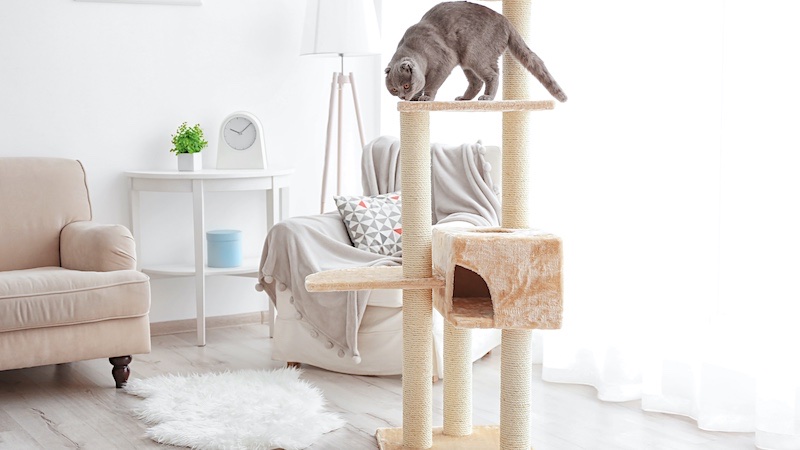Most of the time a scratching cat is just carrying out his natural instincts. It helps them mark their territory, exercise their muscles and keep their claws sharp. But it can also be destructive to furniture and other items in the home if not managed properly.
Here I’m going to explore how best to look after an indoor cat’s paws and claws as well as address common questions such as why a cat need to scratch? Why do they like to scratch furniture? And how can you stop a cat from scratching furniture without causing distress or discomfort for your furry friend?
Understanding Cat Scratching Behavior

Most cats scratch for a variety of reasons, including to mark territory, to stretch and exercise and to sharpen their claws. It is important to understand why cats scratch in order to provide appropriate alternatives and discourage unwanted behavior.
What Are The Benefits Of Cat Scratching?
Scratching provides many benefits for cats beyond just marking territory or keeping nails sharpened; it’s also great exercise. When your cat scratches at something like a vertical scratching post or mat she gets her whole body involved in the activity which strengthens her muscles and keeps her fit.
Plus it gives her an outlet for pent up energy that would otherwise be expressed through destructive behaviors such as clawing furniture or carpeting instead of more appropriate objects like a cat scratching post or mats designed specifically for this purpose.
How Can I Encourage Appropriate Scratching?
The best way to encourage appropriate scratching is by providing your cat with plenty of options when it comes time for him/her to get some much needed stretching in. Invest in several different types of cat scratching posts.
Most cats prefer carpeted, tree bark, sisal rope, wood and even corrugated cardboard. Place various types throughout your home where your cat likes to spend time until your cat finds one he prefers more than your chair legs.
Make sure they’re tall enough so he/she can fully extend his/her body while using them too. You may even want to consider getting one that has multiple levels so there’s always something new and interesting available when he/she needs some extra stimulation during playtime.
Finally, cat owners should reward the use of a new scratching post instead of your dining room table leg with treats every now and then; this will help reinforce positive habits over time.
Understanding cat scratching behavior is essential for pet owners to provide their cats with the appropriate outlets for this natural instinct. By redirecting your cat’s attention away from furniture and providing alternatives, you can prevent unwanted scratching in the home.
Recap: Cats scratch for various reasons, including marking territory and stretching. To encourage appropriate scratching, provide cats with multiple types of posts in different areas around the home. Reward good behavior to reinforce positive habits.
Preventing Cat Scratching the Furniture
Let’s take a look at ways you can stop a scratching cat problem.
Redirecting Your Cat’s Attention Away From Furniture and Other Objects:

Redirecting your cat’s attention away from inappropriate surfaces like furniture or walls can be done by providing alternative surfaces that are more acceptable for scratching. Try placing an attractive post near the object they have been scratching so they will be drawn towards it instead of the forbidden item.
Make sure you reward them with treats when they use the post correctly as this will reinforce positive behaviors.
Providing Appropriate Alternatives For Your Cat To Scratch On:
Providing appropriate alternatives such as posts, mats, cardboard boxes, carpeted stairs or even a piece of wood covered in sisal rope are all great options for encouraging your cat to scratch appropriately instead of on furniture or other objects around the house.
Place these items near areas where your cat has been known to scratch inappropriately so that they will be drawn towards them naturally. You may also want to consider purchasing toys specifically designed for claw care which can help keep their claws healthy while providing entertainment at the same time.
Training your cat not to scratch unacceptable objects requires patience and consistency, but it can be done with some effort. Start by using deterrents such as double sided sticky tape or cooking foil on any area where you don’t want them scratching.
This should discourage them from returning there again for future attempts at claw care activities. If it doesn’t, try spraying water when they approach where you do not want them scratching – this should startle them enough that they won’t return soon after being sprayed.
Finally, make sure you reward good behavior whenever possible. Give treats when they use approved items like posts and mats correctly so that they know what is expected of them going forward.
By redirecting your cat’s attention away from furniture and other objects, providing appropriate an alternative scratching surface for them to scratch on, and training them not to scratch unacceptable objects, you can successfully prevent unwanted scratching in the home.
However, if your cat is displaying signs of anxiety-related scratching issues then additional measures may be necessary.
Recap: Redirecting your cat’s attention away from furniture and other objects and providing appropriate alternatives for them to scratch on can help reduce unwanted scratching. This can be done by placing attractive posts near the object they have been scratching, providing items such as posts, mats, cardboard boxes or carpeted stairs, and using deterrents like double-sided tape or aluminum foil.
Dealing with Anxiety-Related Scratching Issues in Cats
When it becomes excessive or destructive scratching, it can be a sign of anxiety. Identifying signs of stress and anxiety in cats is key to helping them cope with these issues.
Common signs include hiding, avoiding people or other animals, vocalizing excessively, urinating outside the litter box, over-grooming themselves and changes in appetite.
Creating an environment that is conducive to relaxation and comfort for your cat can help reduce anxiety-related scratching behaviors. Providing a safe space where they feel secure such as a cozy bed or window perch will give them somewhere to retreat if they become overwhelmed by their surroundings.
Keeping things like food bowls and litter boxes away from loud noises like washing machines or vacuums will also help reduce stress levels. Additionally, providing plenty of enrichment activities such as interactive toys and puzzle feeders will keep your cat mentally stimulated while giving them something else to focus on instead of anxious behaviors like scratching furniture or carpets.
If necessary, seeking professional help may also be beneficial for severe anxiety issues in cats. Your veterinarian can provide advice on medications that may help alleviate symptoms associated with anxiety disorders as well as lifestyle modifications you can make at home to improve your cat’s quality of life.
In some cases, behavioral therapy may even be recommended depending on the severity of the issue which could involve working with an animal behaviorist who specializes in feline behavior problems specifically related to stress and fear responses in cats
It is important to be aware of the signs of anxiety in cats and create an environment that is conducive to relaxation. With proper care, trimming, and exercise, you can ensure your cat’s claws and paws remain healthy and clean.
Recap: Providing a safe, comfortable environment and enrichment activities can help reduce anxiety-related scratching behaviors in cats. Solutions may include providing a cozy bed or window perch, keeping food bowls and litter boxes away from loud noises, interactive toys and puzzle feeders, and seeking professional help if necessary.
Caring for an Indoor Cat’s Claws and Paws Properly
Claw trimming regularly and safely at home or by a professional groomer or veterinarian is essential for proper claw care and health maintenance of an indoor cats paws.
It is important to keep the claws trimmed to prevent them from becoming overgrown, which can cause discomfort when walking, running, and jumping. If you choose to trim your cat’s nails yourself, make sure that you have the right tools such as nail clippers specifically designed for cats.
Additionally, always be gentle with your pet while trimming their nails and provide plenty of treats afterwards as a reward for good behavior.
Providing appropriate toys, scratching posts, and mats for claw care and exercise at home can also help keep your cat’s claws healthy while discouraging unwanted scratching behavior on furniture or other objects in the home.
A Cat tree is an excellent way to give your pet something fun to scratch on instead of furniture; they come in various sizes so you can find one that fits perfectly into any room in the house.
Additionally, providing cardboard scratchers gives cats another option if they don’t like using their tree; just make sure to replace them often so they stay fresh. Finally, placing double-sided tape on surfaces where you don’t want them scratching will help deter this behavior too.
Keeping your cat’s paws clean and healthy with regular grooming is also very important for overall paw health. This includes brushing out fur between toes regularly (especially during shedding season) as well as cleaning up any dirt or debris that may get stuck there after playing outside or going through litter boxes etc.
Additionally, regular baths will help keep their coat clean which helps reduce skin irritation caused by allergens found outdoors like pollen etc. Lastly, making sure their bedding stays clean should be done weekly; washing it once every two weeks should suffice depending on how much time they spend sleeping there each day.
Recap: Regularly trimming your cat’s nails, providing appropriate scratching toys and posts, keeping their paws clean with regular grooming, and washing bedding weekly are essential for proper claw care and paw health.
FAQ
What do cats feel when you scratch them?

Cats generally enjoy being scratched and petted. It can help them to relax, as well as provide a sense of security and comfort. When cats are scratched in the right spot, they may start to purr or even drool from pleasure. Scratching also helps stimulate their circulation and release endorphins which make them feel good. Cats may rub against you when you scratch them because it is an expression of trust and affection towards you.
Why do cats scratch couches?

If you find cats scratch furniture close to where you spend time such as your favourite couch, it’s because instinctively they are marking the territory where you sit. Place a cat scratching post close by and with a little persuasion you should be able to get them to use the post for the same purpose.
Why do cats scratch you for no reason?

Cats scratch for a variety of reasons, including to mark their territory, as a form of play or exercise, and even out of boredom. When cats feel threatened or uncomfortable in any way, they may also use scratching as a defensive mechanism.
In some cases, cats can become overstimulated during petting sessions and may react by scratching without warning. It is important to be aware of your cat’s body language when interacting with them so that you can recognize signs that they are becoming agitated before the situation escalates into unwanted behavior such as scratching.
How do I get my cat to stop scratching?

Scratching is a natural behavior for cats and it’s important to provide them with an appropriate outlet. Start by providing your cat with scratching posts or boards that are tall enough for them to stretch out fully when they scratch. Place the scratching post near the cat’s bed or favorite napping spots.
Try keeping a cat from scratching furniture by using double-sided sticky tape, foil, or plastic carpet runners on furniture and other surfaces you don’t want scratched. Additionally, trimming his claws regularly will help reduce damage from scratching and make it easier for them to grip onto the scratching post instead of furniture. Finally, reward positive behaviors such as using the scratching post with treats and praise.
Why is my cat scratching but has no fleas?

Scratching is a normal behavior for cats but if you notice him scratch vigorously or showing signs of discomfort while doing so, then he may have an underlying medical issue such as allergies or skin irritation.
Fleas are one possible cause of this itching sensation but there are other potential causes too including mites, bacterial infections and fungal infections. If you suspect that your cat has fleas, it’s important to take them to the vet for a thorough examination and treatment plan. Additionally, look out for any changes in behavior such as excessive grooming or licking which could indicate another health issue unrelated to fleas.
Conclusion
Overall, scratching is a natural behavior for cats and it can be difficult to stop them from doing it. However, by understanding why cats scratch and taking the necessary steps to prevent unwanted scratching in the home, you can help your cat stay healthy and happy while also protecting your furniture.
Additionally, if you suspect that anxiety may be causing your cat to scratch excessively, seek professional advice from a veterinarian or animal behaviorist who can provide guidance on how best to address this issue. By taking these measures and properly caring for an indoor cat’s claws and paws with regular nail trims, you’ll have a better chance of keeping both your pet and furniture safe from any potential damage caused by “scratching cat” behavior.
Do you want to keep neighbourhood cats out of your garden to prevent your indoor cat catching fleas or worse? Check out my long term testing of various cat deterrents.





